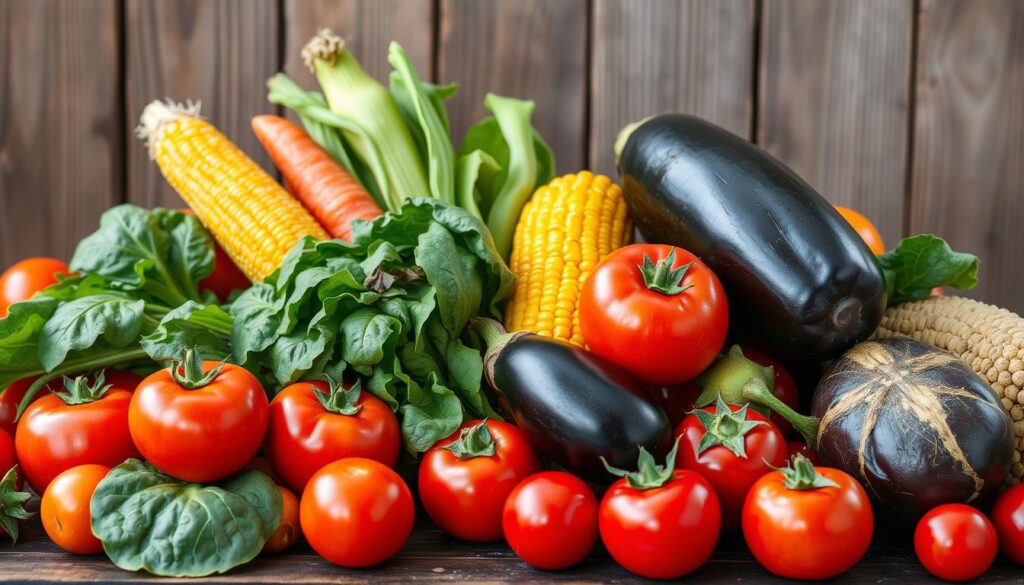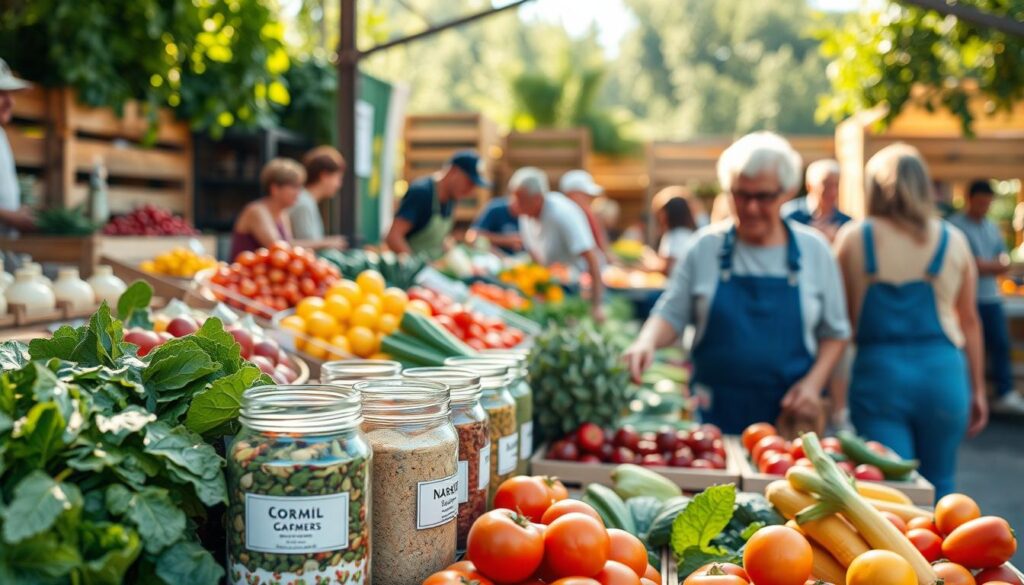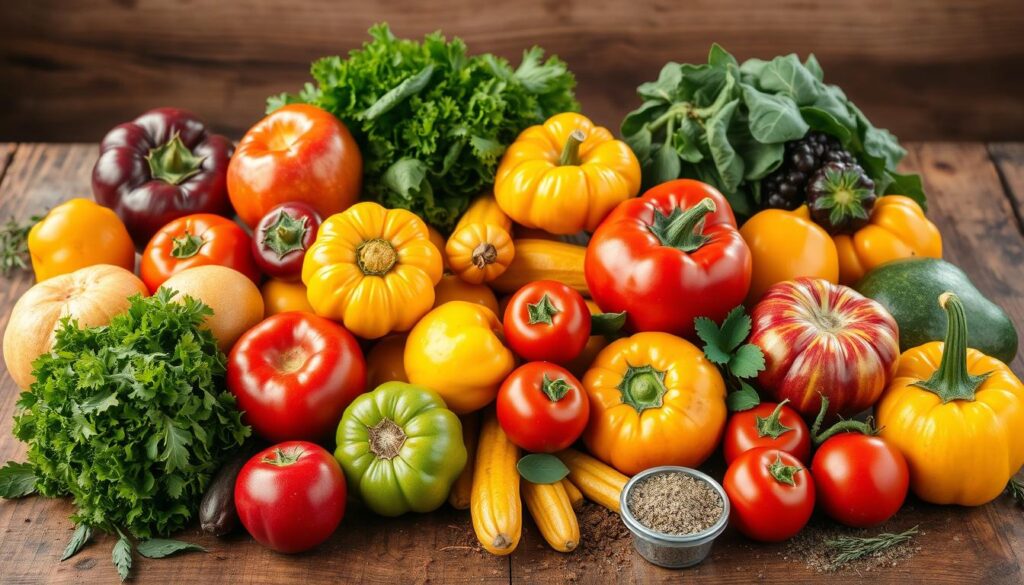In today’s fast world, convenience often wins over health. Have you thought about the food you serve your family? Many processed foods have artificial colors, which can harm our health. But, switching to no artificial colors can greatly benefit your family.
Imagine a world where natural colors are the focus, and your family’s health is the top priority. This journey will show you how vibrant, natural colors can improve your family’s health.
Key Takeaways
- Artificial colors in processed foods can have negative impacts on children’s behavior and health
- Choosing natural ingredients and clean label products supports long-term well-being
- Ditching additive-free foods helps reduce environmental footprint
- The Food Scan Genius app empowers you to decipher food labels and make informed choices
- Embrace a world of vibrant, color-rich foods from nature’s palette
Ready to unlock the power of natural colors and transform your family’s health? Let’s dive in and uncover the secrets to a more vibrant, nourishing future.
Understanding Artificial Colors in Modern Food Products
Choosing healthier foods for our families is important. We need to know about artificial colors in processed foods. These colors, made from petroleum or coal tar, are everywhere. They make our drinks and snacks look more appealing.
Common Synthetic Dyes in Processed Foods
Some common artificial colors include:
- FD&C Red No. 40 (Allura Red AC)
- FD&C Yellow No. 5 (Tartrazine)
- FD&C Blue No. 1 (Brilliant Blue FCF)
- FD&C Green No. 3 (Fast Green FCF)
Health Implications of Artificial Food Coloring
Artificial dyes make food look better, but they might not be good for us. Research suggests they could cause problems in kids, like behavioral issues and allergies. We still don’t know all the effects of eating these additives.
FDA Regulations and Safety Concerns
The FDA checks if artificial colors are safe in food. They say these dyes are okay in small amounts. But, many people worry about their safety. As more people want dye-free and real food, the industry and regulators are under pressure.

“We are what we eat, and what we eat matters. By choosing organic and non-synthetic foods, we help our health and the health of our loved ones.
The Rise of Clean Label Movement
A big change is happening in the world of food and nutrition – the clean label movement is growing. People want to know what’s in their food. They want pure, wholesome ingredients they can understand.
This change is making the food industry adapt. Companies are now focusing on clean label products to meet consumer needs. The clean label movement is a lasting change in how we view food.
At the core of this movement is a push for natural ingredients. People are saying no to artificial additives and synthetic dyes. They want to know what they’re eating and are willing to pay more for it.
The clean label movement is more than just a fad – it’s a reflection of our growing awareness of the impact our food choices have on our health and the environment.
Food companies are now changing their recipes. They’re removing bad ingredients and using pure, wholesome ones instead. This change is making our food better and starting important conversations about food transparency.
The clean label movement shows the power of consumer choice. By choosing what they eat, people are pushing for better food. This is an exciting time for the future of food.

Benefits of Choosing No Artificial Colors
Choosing to avoid artificial colors in our food is a big change. It leads to better health, a cleaner environment, and happier kids. Opting for foods without additives means we get real, natural ingredients.
Impact on Children’s Behavior and Health
Artificial food dyes can really affect kids. They can make children more hyperactive, inattentive, and even aggressive. By removing these dyes, we help our kids stay calm and focused.
Long-term Health Advantages
Choosing organic, additive-free foods is good for more than just now. It can lower the risk of allergies, asthma, and even cancer. Natural colors are safer for our health over time.
Environmental Benefits
- Less harm to the environment from synthetic dyes and pigments.
- More support for farming that uses organic and natural ingredients.
- Less need for food additives made with lots of resources and chemicals.
Switching to additive-free, real food with natural ingredients is good for us and the planet. It improves our health, our kids’ behavior, and supports sustainable farming.
Natural Alternatives to Synthetic Food Dyes
Ready to ditch artificial food coloring? Nature has amazing non-synthetic, plant-based colors for your meals. Beetroot’s earthy tones and turmeric’s bright yellow can transform your dishes.
Discover a rainbow of natural options to replace artificial dyes. These non-synthetic alternatives are not only beautiful but also healthy:
- Beetroot: This root vegetable gives a deep-red color, great for frosting and pasta.
- Turmeric: Its golden-yellow adds flavor and color to many plant-based and organic foods.
- Spirulina: This algae creates a blue-green shade, perfect for drinks, baked goods, and more.
- Annatto: From the achiote tree, annatto offers a warm orange for cheese, sauces, and more.
- Paprika: Whether smoked or sweet, paprika adds vibrant red to rice, roasted veggies, and more.
With nature’s colors, your dishes can shine brighter. Choose non-synthetic, plant-based, and organic dyes for stunning results.
| Natural Dye | Source | Color Provided | Common Uses |
|---|---|---|---|
| Beetroot | Beetroot | Deep red | Frosting, pasta, baked goods |
| Turmeric | Turmeric root | Vibrant yellow | Beverages, baked goods, rice |
| Spirulina | Blue-green algae | Blue-green | Beverages, baked goods |
| Annatto | Achiote tree seeds | Warm orange | Cheese, sauces, rice |
| Paprika | Dried peppers | Vibrant red | Rice, roasted vegetables |
“Embrace the power of nature’s own color palette and let your culinary creations shine brighter than ever before.”
Reading Food Labels: Identifying Hidden Artificial Colors
Understanding food labels can be tough, but we’re here to help. We’ll teach you how to spot hidden artificial colors in your favorite foods.
Common Names and Code Numbers
Artificial colors have many names like FD&C Red No. 40 or E133 Brilliant Blue FCF. Keep an eye out for these names on labels. Choose products with fewer ingredients, like clean label, additive-free, and dye-free options.
Misleading Marketing Terms
Watch out for terms like “natural colors” or “no artificial flavors.” They might still have synthetic dyes or additives. Always check the ingredient list to make sure you’re getting dye-free products.
Using Food Scan Genius App for Label Reading
The Food Scan Genius app makes reading labels easy. Just scan a barcode, and it will show you any artificial colors or additives. It’s a great tool for finding additive-free foods for your family.
The Food Scan Genius app has been a game-changer for my family. It takes the guesswork out of label reading and helps us make healthier choices with ease.
Making the Switch to Dye-Free Foods
Are you ready to start a new journey towards a healthier diet for your family? Switching to dye-free foods can change your life. We’re here to help you every step of the way. Say goodbye to artificial ingredients and hello to pure, real food that’s good for you and tastes great.
First, check your pantry and fridge. Get rid of any processed foods with synthetic food dyes. Then, replace them with natural, wholesome alternatives. It might seem hard, but we’ve got a simple checklist to help you.
- Look for dye numbers like Red 40, Yellow 5, and Blue 1. These are not allowed in our natural ingredients home.
- Choose real food with natural colors like beets, turmeric, or annatto. These colors are not only beautiful but also good for you.
- Use pure, unprocessed ingredients like fresh fruits and veggies. They add a rainbow of flavors to your meals.
- Try making your own dressings, sauces, and baked goods. You’ll find it’s easy to make natural, vibrant colors with simple ingredients.
The journey to a dye-free lifestyle is a step-by-step process. Be kind to yourself and celebrate small wins. Soon, your family will join the natural, real food movement, and your taste buds will thank you.
Choosing natural, wholesome foods is not just a trend – it’s a lifestyle that can transform your health and well-being.
Natural Food Sources for Vibrant Colors
Forget artificial dyes and synthetic coloring. Nature offers the most vibrant colors we need. You can add natural color to your meals with organic, non-synthetic, plant-based, real food options.
Plant-Based Color Options
The world of plant-based foods is full of colors. Try adding these natural colors to your diet:
- Beets – deep, earthy red
- Turmeric – vibrant golden yellow
- Spinach – lush, verdant green
- Pomegranate seeds – ruby-red jewel tones
- Butterfly pea flower – electric blue
Seasonal Color-Rich Foods
Many colorful organic, non-synthetic foods are seasonal. This means you can enjoy a changing palette of produce all year. Look out for these seasonal stars:
- Spring: Asparagus, rhubarb, radishes
- Summer: Tomatoes, berries, peppers
- Fall: Pumpkins, sweet potatoes, apples
- Winter: Citrus fruits, leafy greens, winter squash
Using plant-based, real food colors makes meals both beautiful and healthy. Let your plate shine with vibrant, natural colors.
Shopping Guide for Artificial Color-Free Products
Shopping just got easier! We’ve got a shopping guide to help you find artificial color-free products. You’ll find wholesome snacks, vibrant produce, and household items.
First, look for trusted brands. Amy’s, Nature’s Path, and Annie’s Homegrown offer additive-free and dye-free products. Their clean labels are easy to spot.
But there’s more to find! Explore local health food stores, farmers’ markets, and your neighborhood grocery. You’ll discover a world of Food Scan Genius-approved, clean label products. Natural, vibrant foods and household goods are waiting for you.
FAQ
What are the benefits of choosing foods without artificial colors?
Choosing foods without artificial colors is good for your family’s health and the planet. Artificial colors can cause problems in kids and might harm health over time. Plus, natural colors are better for the environment.
How can I identify hidden artificial colors on food labels?
It’s not always easy to read food labels, but there are ways to spot artificial colors. Look for names like FD&C Red 40 or Yellow 5. Also, watch out for terms like “color” or “artificial color.” The Food Scan Genius app can help you find artificial additives fast.
What are some natural alternatives to synthetic food dyes?
Nature has many natural colors like beetroot, turmeric, and spirulina. These colors are just as bright as artificial ones but are safer for your health.
How can I make the switch to dye-free foods for my family?
Switching to dye-free foods is simple. First, clean out your pantry and choose whole foods over processed ones. Look for brands with clear labels. The Food Scan Genius app can also guide you to dye-free products.
Where can I find natural color-rich foods to incorporate into my meals?
Nature has many colorful foods to add to your meals. Try berries, leafy greens, carrots, and squash. These foods make it easy to “eat the rainbow” naturally.





